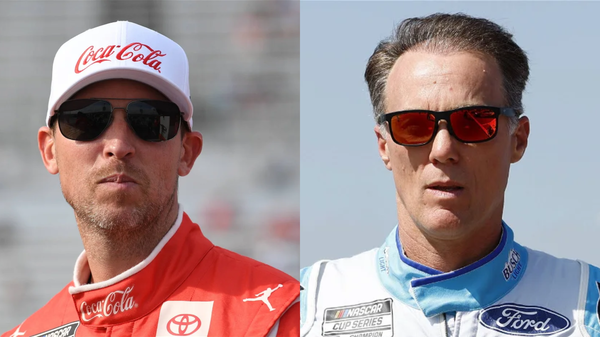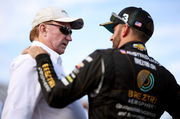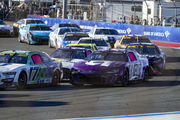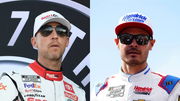
via Imago
Denny Hamlin, Kevin Harvick | Credits – Imago

via Imago
Denny Hamlin, Kevin Harvick | Credits – Imago
The 2024 Cup Series season keeps on delivering, and the fans can’t get enough of it! This weekend at Bristol Motor Speedway was perhaps the most exciting day of short-track racing that we’ve experienced in a long time, and the sport’s veterans wasted no time pointing out that this was a step in the right direction. Amidst demands from Denny Hamlin for NASCAR to introduce higher horsepower as a solution to lackluster short-track racing, the high tire degradation played the cards right into the hands of the most experienced drivers.
With Hamlin taking the win as the day wrapped up, the community now believes that, maybe, higher horsepower isn’t really the solution. Although Kevin Harvick may not be in the driver’s seat this year, the former SHR star believes the solution is right below the Next Gen car’s feet.
ADVERTISEMENT
Article continues below this ad
Kevin Harvick believes more horsepower is not the answer to NASCAR’s short-track dilemma
Before NASCAR even arrived at Bristol Motor Speedway, talks of the increasing need for higher horsepower had taken the community by storm. From drivers such as Kyle Larson to Hamlin himself stating that the officials could introduce this change that we all seem to want ‘as soon as next week’, the pressure was on NASCAR to deliver something unique in Bristol. While the degradation may not have been a pleasant surprise for drivers during practice and qualifying, the way the race unfolded ultimately satisfied almost every stakeholder.
With that said, Kevin Harvick believed the answer to NASCAR’s short-track dilemma was right in front of everyone’s eyes. Harvick analyzed the tire degradation on the latest episode of Harvick’s Happy Hour, “Look, we talked about horsepower last week right, we were searching for problems to solve things that we thought could make it better. Well, guess what? We don’t need any freaking horsepower. If we can make tires like that, we don’t need more horsepower.”
For the longest time, the sport had been against the idea of introducing more horsepower. The reason? It may hamper the entry timeline for a new OEM. While this was a solid argument, Harvick felt that this weekend at Bristol created a solid argument in favor of improving the tire package instead of messing with the powertrain.
Harvick shared, “We didn’t know this was even an option. Well, it’s an option, because we have proven that it’s an option, so. I wanna know why, I want to know how this happened and I want to see it happen again…(..)..if you don’t have anything else, go ahead and bring those back. They’ll figure it out. Those teams will get better.”
It’s no secret that this weekend in Bristol was unlike any other. But once all the dust had settled, it became evident that both the drivers and fans were delighted. With that said, Goodyear also revealed how it was the driver’s wishes for more tire wear that led to the creation of such a compound. Now that the short-track battles can be decided by skill and tire management instead of boring mileage, higher horsepower may not be required!
READ MORE: Concrete Bristol Shatters Own Record Amidst NASCAR’s Triumphant Tire-Management Return
While it’s safe to say Kevin Harvick wasted no time in dismissing Denny Hamlin’s horsepower claims, the veteran also drowned out any voices stating that the resin and concrete were responsible for the degradation.
Trending
ADVERTISEMENT
Article continues below this ad
Was the resin really not responsible for Bristol’s high tire degradation?
Over the last three years, Bristol Motor Speedway has seen dirt racing’s Cup Series revival for the first time since the 1970s. With that said, the novelty of the dirt eventually wore off, leading many to want the return of the concrete. But when it did, many pointed out how the use of resin over the standard PJ1 had resulted in higher tire degradation. However, Harvick revealed that the resin had nothing to do with what we witnessed this weekend at Bristol, at least in terms of tire wear.
Harvick shared on his podcast that he had gained some insight from the crew members who had been to the wet weather test at Bristol a few weeks prior. The veteran stated, “We went back with the resin on the bottom of the racetrack this time because the PJ1 was too slick in the rain, and that’s how they tested. They tested with the PJ1 residual on the racetrack. It’s not a resin or PJ1 thing because when they tested with the PJ1 on the racetrack at the tire test for the wet weather test, the track did the same thing, the tires were worn out in 25–30 laps, and they had high tire wear.”
For the crew members present, Harvick believed it was an assumption that the degradation was caused by the freshly laid concrete. Eventually, the degradation would wear out. However, this is when Kevin Harvick revealed that the ‘freshly laid concrete’ was actually the existing PJ1. He concluded, “It was on the PJ1 that was left over, there was no track treatment, it was just how it was in the fall. So that tells me that the resin didn’t have anything to really do with what we had on the racetrack. It was the tire, and I loved it. I loved every minute of it.”
ADVERTISEMENT
Article continues below this ad
READ MORE: Denny Hamlin Confesses to Conspiring with Kyle Larson at Bristol
Kevin Harvick not only believes that Hamlin’s horsepower demands aren’t the answer to the short-track dilemma, but he also believes Goodyear is heading in the right direction. With that said, do you think we’re going to see more of such racing at Martinsville too?
ADVERTISEMENT
ADVERTISEMENT
ADVERTISEMENT
ADVERTISEMENT







